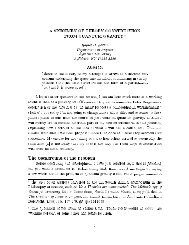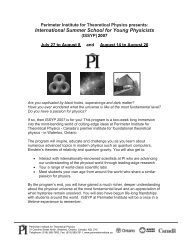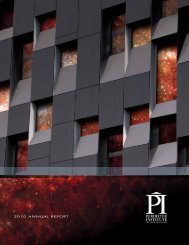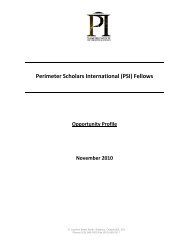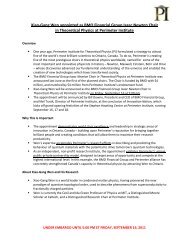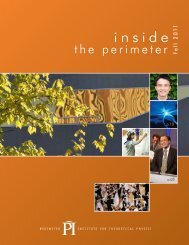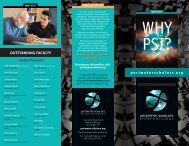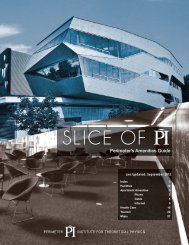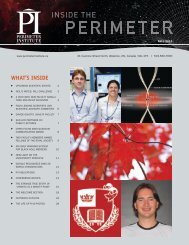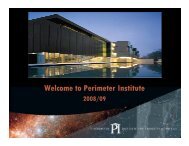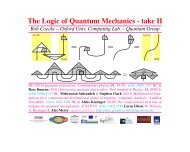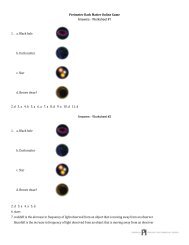(2011-09-29) Postdoctoral Introduction - Perimeter Institute
(2011-09-29) Postdoctoral Introduction - Perimeter Institute
(2011-09-29) Postdoctoral Introduction - Perimeter Institute
You also want an ePaper? Increase the reach of your titles
YUMPU automatically turns print PDFs into web optimized ePapers that Google loves.
Director<br />
Professor Neil Turok<br />
Neil Turok is the Director and a senior Faculty member at <strong>Perimeter</strong> <strong>Institute</strong>. He earned<br />
his PhD at Imperial College, held a postdoctoral fellowship in Santa Barbara, and was an<br />
Associate Scientist at Fermilab before moving to Princeton University, where he became<br />
Professor of Physics in 1994. In 1997, he was appointed to the Chair of Mathematical<br />
Physics in the Department of Applied Mathematics and Theoretical Physics (DAMTP) at the<br />
University of Cambridge. In October 2008, he joined <strong>Perimeter</strong> <strong>Institute</strong> as its Director.<br />
Among his many honours, Professor Turok was awarded Sloan and Packard Fellowships<br />
and the 1992 James Clerk Maxwell medal of the UK <strong>Institute</strong> of Physics.<br />
Professor Turok has worked in a number of areas of theoretical physics and cosmology,<br />
focusing on developing fundamental theories and new observational tests. In the early<br />
1990s, his group showed how the polarization and temperature anisotropies of the cosmic<br />
background radiation would be correlated, a prediction confirmed in detail by recent precision measurements. The<br />
team also developed a key test for the presence of the cosmological constant, also recently confirmed. With<br />
Stephen Hawking, he later developed the Hawking-Turok instanton solutions describing the birth of inflationary<br />
universes.<br />
More recently, with Paul Steinhardt at Princeton, he has developed a cyclic model for cosmology, according to<br />
which the big bang is explained as a collision between two “brane-worlds” in M-theory. In 2006, Steinhardt and<br />
Turok showed how the model naturally allowed the cosmological constant to relax to very small values, consistent<br />
with current observations. Steinhardt and Turok co-authored the popular science book Endless Universe: Beyond<br />
the Big Bang. In 20<strong>09</strong>, Professor Turok was named a Canadian <strong>Institute</strong> for Advanced Research (CIFAR) Fellow in<br />
the cosmology and gravitation program.<br />
Born in South Africa, Professor Turok founded the African <strong>Institute</strong> for Mathematical Sciences (AIMS) in 2003.<br />
Based in Cape Town, this postgraduate educational centre supports the development of mathematics and science<br />
across the African continent (see www.aims.ac.za and www.nexteinstein.org). For this work and his contributions to<br />
theoretical physics, he was awarded the TED Prize (www.ted.com) and a “Most Innovative People” award at the<br />
2008 World Summit on Innovation and Entrepreneurship (WSIE).<br />
4



